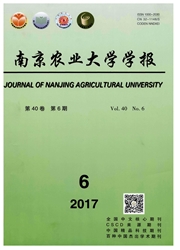

 中文摘要:
中文摘要:
在田间条件下,以豫麦34和扬麦9号2个蛋白质含量不同的小麦品种为材料,花后用0.01mol·mL^-16-BA分别处理穗部和旗叶,研究6-BA对小麦花后植株C/N物质积累与转运规律的影响及其与小麦籽粒蛋白质和淀粉形成的关系。结果表明,6-BA处理降低了小麦籽粒质量和总淀粉含量,但显著提高了籽粒蛋白质含量,且旗叶处理比穗部处理的效果更为显著。6-BA处理显著提高了籽粒谷蛋白含量,对清蛋白和球蛋白的影响较小;穗处理的籽粒醇溶蛋白含量低于对照和旗叶处理,使穗处理的谷蛋白/醇溶蛋白显著增加。与对照相比,6-BA处理降低了扬麦9号籽粒支链淀粉含量,豫麦34在不同处理间无显著差异。6-BA处理降低了营养器官花前贮存干物质和氮素的转运量与转运率,也降低了花后干物质积累量,但提高了花后氮素同化量及同化氮索对籽粒氮的贡献率。与穗处理相比,旗叶处理降低了花前贮藏干物质和氮素运转量对籽粒产量和氮素积累量的贡献率,但提高了花后同化干物质和氮素对籽粒产量和氮素积累量的贡献率。上述结果表明6-BA处理促进了籽粒蛋白质的合成,但降低了籽粒质量和淀粉的合成,旗叶处理较穗处理作用大。
 英文摘要:
英文摘要:
Field experiment was conducted using two wheat cultivars Yangmai 9 and Yumai 34 differing in grain protein content to investigate the effect of 6-BA on translocation and accumulation of carbon and nitrogen after anthesis and its relationships with grain weight and quality formation. Flag leaf and spike were treated with 0.01 mol·mL^-1 6-BA at 10 d after anthesis with water as control. The results showed that single grain weight and starch content were reduced under two 6-BA treatments, but the contents of crude protein and glutenin were significantly increased as compared with control. The gliadin content was decreased under spike treatment, which resulting in significant increasing of glutenin/gliadin ratio. Grain amylopectin content in Yangmai 9 was reduced. There was slightly effect of 6-BA on starch components content of Yumai 34. Furthermore, translocation amount and rate of nitrogen and dry matter stored in vegetative organs before anthesis were reduced by 6-BA treatments. The post-anthesis dry matter accumulation was also reduced, but nitrogen accumulation and contribution to grain were obviously enhanced under 6-BA treatments. Compared with spike treatment, flag leaf treatment reduced contribution of pre-anthesis nitrogen and dry matter stored in vegetative organs, but increased contribution of post-anthesis assimilated nitrogen and dry matter to grain. The results suggested that protein content was increased under 6-BA treatments, but single grain weight and starch content were decreased after anthesis. In addition, the effects of flag leaf treatment on protein and starch formation were much higher than those of spike treatment.
 同期刊论文项目
同期刊论文项目
 同项目期刊论文
同项目期刊论文
 期刊信息
期刊信息
